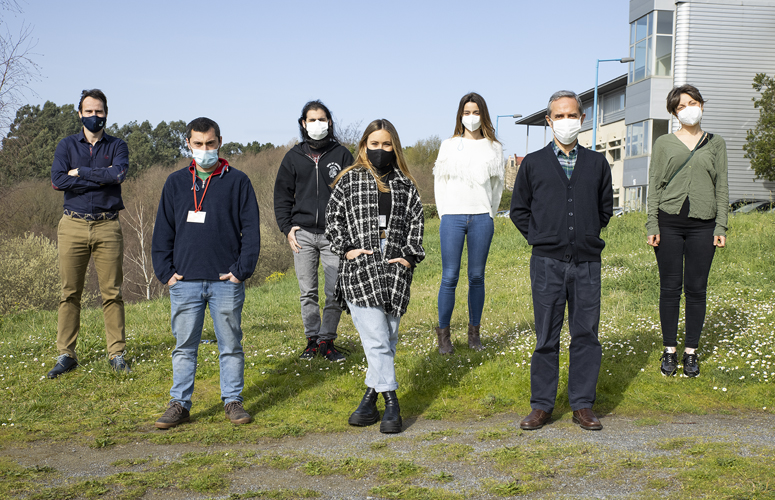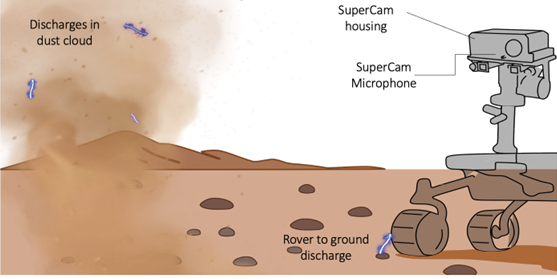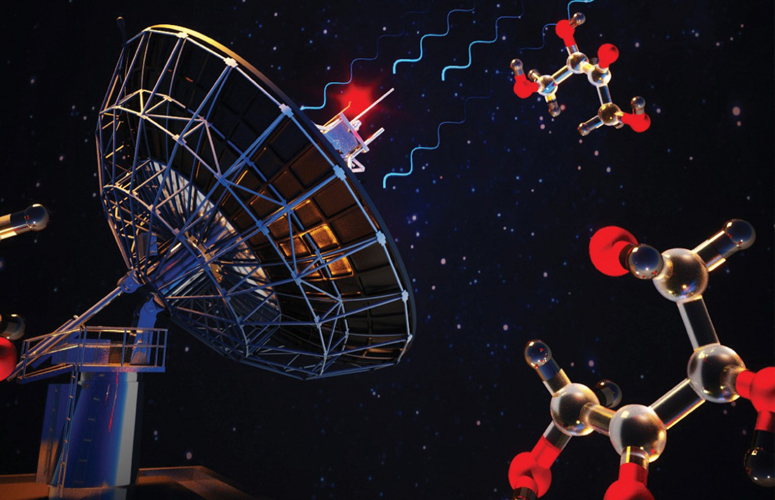Although over 200 molecules have been detected in the interstellar medium, no sugars have yet been found. The UPV/EHU Spectroscopy Group has overcome the main difficulty involved in detecting the rotational spectra of sugars, which lies in its vaporisation. In collaboration with other research teams, they have managed to determine the hyper-precise molecular structure of erythrulose and have searched for spectroscopic signals of this sugar in space.
Researchers at the UPV/EHU are searching for sugars in interstellar space
They have developed a new experimental procedure which overcomes the difficulties currently hampering the search for sugars in space
- Research
First publication date: 22/03/2021

The presence of carbohydrates in the interstellar medium may be linked to the appearance of life on Earth. The question of the origin of life has intrigued humans for centuries, and is currently one of the most popular research topics in the fields of astrochemistry and astrobiology. The detection of over 200 molecules in interstellar space suggests that prebiotic molecules are present in that medium. Consequently, the detection in interstellar space of sugars or other essential molecules, such as amino acids, nucleobases, or fatty acids, which are vital to all known life forms, is crucial to modelling the reactions and formation pathways of more complex organic molecules that are related to life. 'Detecting these biomolecules may shine some light on the initial process of the origin of life. No sugars have yet been detected, only certain sugar precursors,' explains Emilio J. Cocinero, lead researcher with the UPV/EHU's Spectroscopy Group.
'To find any molecule in space, we need to use rotational spectroscopy. This technique enables us to determine the structure of a single isolated molecule with a very high degree of precision. It's almost like taking its fingerprint. Rotational spectroscopy is the first step in finding these molecules in interstellar space,' adds Cocinero. Space is filled with a huge number of signals from all the molecules that make it up. It is therefore impossible to establish a signal « molecule relationship without first characterising each molecule in the laboratory. Once this has been done, radio-astronomers can search for these previously characterised signals in different areas of interstellar space, using radio telescopes'.
Sugars became caramel
Rotational spectroscopy is a high-resolution technique that works with samples in the gas phase. 'Sugars are solids, and the problem is that when we heat them to turn them into a gas, they just become caramel; this means that sugars do not vaporise, they just decompose and break down into smaller molecules,' explains the researcher. However, the research group has managed to develop a 'vaporisation technique which enables us to generate this sugar in the gas phase, thereby avoiding this decomposition process. The sugar, in this case erythrulose, is mixed with a compaction agent before being pressed and dried. Finally, this solid bar is vaporised using an ultraviolet ultra-fast laser, thereby obtaining erythrulose molecules in the gas phase,' he adds. The procedure is a general one. 'We have developed an experimental method to study other sugars also,' says Cocinero, who is also a member of the Biofisika Institute (UPV/EHU, CSIC). The study has also managed to determine the hyper-precise structure of erythrulose.
At the Spectroscopy Group's laboratory in the UPV/EHU's Department of Physical Chemistry, they design and manufacture their own high-resolution instruments and focus particularly on the study of sugars. 'Sugars are about twenty years behind in comparison with the detection of amino acids, for example; they have basically been overlooked until now, although certain sugar precursor molecules, with two or three units of carbon, have been detected in the interstellar medium. Erythrulose is the next step, because it has four units of carbon. In recent years, the detection of molecules in space has increased exponentially, mainly due to a notable improvement in the capacity of radio telescopes. Moreover, we know that the larger the molecule, the more difficult it is to detect. But as the sensitivity of radio telescopes increases, it is important to detect larger and larger molecules, since this will provide us with information about how the first living beings were formed,' claims Cocinero.
The researcher is delighted to be collaborating with astronomers to search for and detect erythrulose using new experimental data. So far, they have searched in three different regions of the interstellar medium, although to date, the results have been negative in all of them. 'We have not yet found any erythrulose signals in the interstellar medium, but it wouldn't surprise me if we were to detect it in a few years' time, once the detection capacity of radio telescopes has improved. The data gathered to date will help inform future searches and possible detections in other regions of interstellar space'.
Bibliographic reference
Aran Insausti, Elena R. Alonso, Belen Tercero, José I. Santos, Camilla Calabrese, Natalja Vogt, Francisco Corzana, Jean Demaison, Jose Cernicharo, and Emilio J. Cocinero
Laboratory Observation of, Astrochemical Search for, and Structure of Elusive Erythrulose in the Interstellar Medium
'The Journal of Physical Chemistry Letters'
DOI: 10.1021/acs.jpclett.0c03050






